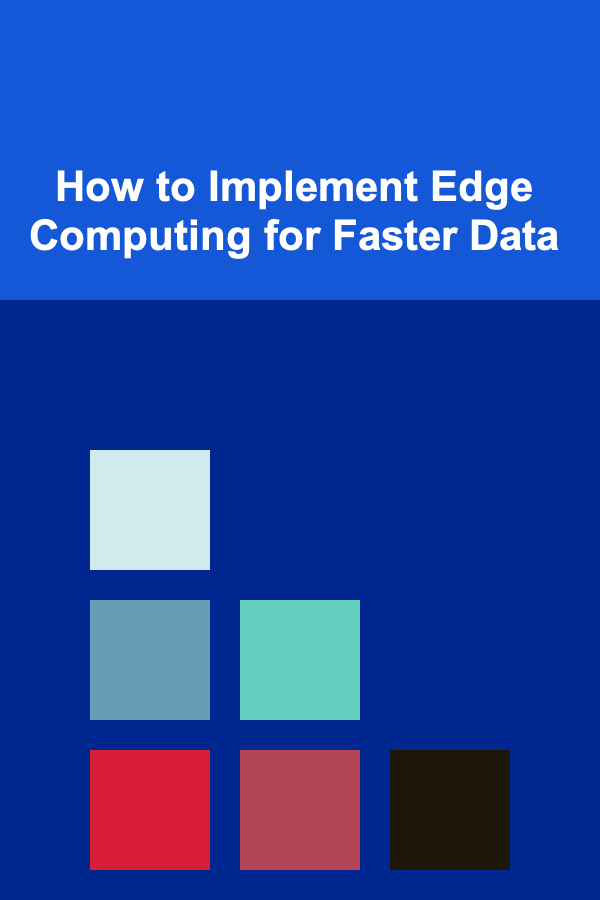
How to Implement Edge Computing for Faster Data
ebook include PDF & Audio bundle (Micro Guide)
$12.99$5.99
Limited Time Offer! Order within the next:

In an era where data-driven decisions are pivotal to the success of businesses, industries, and even entire economies, speed and efficiency have become key factors in data processing. Traditional centralized cloud computing architectures, though effective, often struggle with latency and bandwidth issues when handling vast volumes of data. Enter Edge Computing --- a paradigm that promises faster data processing, reduced latency, and more efficient use of bandwidth by shifting data processing from centralized data centers to the edge of the network.
In this article, we will explore the concept of edge computing, its key components, the benefits it offers for faster data processing, and a step-by-step guide on how to implement it. We'll delve into the architectural, technical, and operational considerations required for effective edge computing deployment. By the end of this piece, you will have a comprehensive understanding of edge computing and how to leverage its potential for your data-centric applications.
What is Edge Computing?
Edge computing refers to the practice of processing data closer to the source of data generation, rather than sending all the data to a centralized cloud or data center for processing. This shift reduces the need for long-distance communication, thereby decreasing latency and improving the overall responsiveness of applications. The "edge" in edge computing represents the outermost layer of a network, where devices and sensors interact with the physical world.
Key Components of Edge Computing
- Edge Devices: These are the physical devices or sensors that generate data. Examples include IoT devices, mobile phones, industrial machinery, and autonomous vehicles.
- Edge Nodes: These are the intermediate processing units that are deployed near the edge devices. Edge nodes perform localized computation and data storage, processing data before sending only the necessary information to the cloud or data center.
- Edge Servers: These are powerful computing servers deployed in close proximity to edge devices. They perform heavier computational tasks, such as data aggregation, analytics, and sometimes machine learning tasks.
- Edge Network: The network connecting all edge devices, nodes, and servers, enabling communication and data exchange.
- Cloud or Centralized Data Center: While edge computing minimizes reliance on the cloud, it doesn't eliminate it entirely. The cloud acts as the central repository for data storage and backup, and it can also perform deeper analysis for long-term insights.
How Edge Computing Differs from Traditional Cloud Computing
Traditional cloud computing relies on a centralized architecture where data is collected from devices and sent to a cloud data center for processing. While this model works well for non-time-sensitive tasks, it suffers from a couple of drawbacks when it comes to real-time processing:
- Latency: The time it takes for data to travel from the source (edge device) to the cloud data center and back can introduce significant delays. For applications like autonomous driving or industrial automation, this latency can be detrimental.
- Bandwidth Constraints: Transmitting large amounts of data to the cloud for processing can consume considerable bandwidth and result in higher operational costs. It may also cause network congestion in environments with thousands of connected devices.
In contrast, edge computing brings computation and data storage closer to the data source, reducing both latency and bandwidth requirements. This local processing ensures faster data access, real-time decision-making, and more efficient use of network resources.
The Benefits of Edge Computing for Faster Data
- Reduced Latency: By processing data near the source, edge computing reduces the distance between data generation and processing, resulting in lower latency. This is especially critical for real-time applications such as autonomous vehicles, augmented reality (AR), virtual reality (VR), and healthcare monitoring.
- Improved Bandwidth Efficiency: Edge computing allows for local processing and filtering of data, sending only relevant information to the cloud or data center. This reduces the amount of data transferred, leading to significant savings in bandwidth and cost.
- Enhanced Reliability and Availability: Edge computing systems can continue to operate even when cloud connectivity is lost. Edge devices and nodes can perform local processing and store critical data until the network is restored, improving system resilience.
- Real-Time Decision Making: Edge computing enables immediate data processing, making it possible to make timely decisions based on real-time insights. For instance, in industrial settings, edge computing can analyze data from sensors and machines in real time, allowing for proactive maintenance and minimizing downtime.
- Scalability: As the number of IoT devices and sensors grows, edge computing provides a scalable approach by distributing the computational load across multiple edge nodes, alleviating the burden on centralized cloud systems.
- Data Privacy and Security: With edge computing, sensitive data can be processed locally, reducing the risk of exposure when transmitting data over networks. In addition, organizations have more control over data security at the edge, making it easier to enforce strict privacy policies.
Challenges in Implementing Edge Computing
While edge computing offers numerous advantages, its implementation is not without challenges. Some of the hurdles organizations might face include:
- Complexity in Infrastructure: Implementing an edge computing infrastructure requires deploying a network of edge devices, nodes, and servers, each with its own configuration and requirements. Managing this distributed system can be more complex compared to a traditional centralized cloud setup.
- Data Synchronization and Integration: Since edge nodes operate independently, synchronizing data between different nodes and the cloud can be challenging, particularly in dynamic environments where the volume of data constantly changes.
- Device Management: With numerous edge devices deployed across various locations, managing and maintaining these devices becomes more difficult. Ensuring device compatibility, updating firmware, and monitoring device performance are important aspects of edge computing deployment.
- Security Concerns: Edge devices are often deployed in remote and unsecured environments, making them vulnerable to physical and cyberattacks. It is crucial to implement strong security protocols to safeguard data and devices at the edge.
- Energy Consumption: Edge computing devices often run in remote or resource-constrained environments, requiring efficient energy management to ensure optimal performance. Power consumption can become a concern, particularly for battery-powered devices.
Step-by-Step Guide to Implementing Edge Computing for Faster Data
Implementing edge computing is a multi-step process that requires careful planning, the right technology, and a strategic approach. Below is a step-by-step guide to help organizations deploy edge computing to achieve faster data processing:
Step 1: Define Your Use Case
The first step in implementing edge computing is to define the use case and understand the specific data processing requirements. This step is crucial for determining the scope of your edge computing deployment, including which devices will generate data, the volume of data, and the processing power needed at the edge.
Key questions to consider:
- What are the specific data processing tasks you need to perform at the edge?
- How fast does the data need to be processed (real-time or batch)?
- What devices and sensors will be involved in the process?
- Are there any specific regulatory or privacy concerns related to your data?
Step 2: Choose the Right Edge Devices and Infrastructure
Selecting the appropriate edge devices, nodes, and servers is critical to the success of your deployment. You need to ensure that these devices have the required processing power, storage, and connectivity to handle your data requirements.
Considerations for choosing the right infrastructure:
- Processing Power: Choose devices with enough computational capacity to handle the data processing workload.
- Storage: Ensure that edge nodes can store relevant data locally, as some data may need to be processed without waiting for cloud connectivity.
- Connectivity: Determine how edge devices will communicate with one another and with the cloud. Options include Wi-Fi, cellular, Bluetooth, and more.
- Scalability: Your infrastructure should be able to scale with growing numbers of edge devices and increasing data volumes.
Step 3: Implement Edge Computing Software
Edge computing requires specialized software to manage data processing, storage, and communication between devices. This software layer enables edge nodes to process data locally, apply analytics, and send relevant insights to the cloud for further analysis.
Key software components to consider:
- Edge Analytics Platforms: Tools that allow data to be analyzed locally on edge devices and nodes.
- Containerization and Virtualization: Technologies like Docker and Kubernetes allow you to deploy lightweight containers that can run on edge devices, ensuring scalability and flexibility.
- Data Management: Ensure that your edge computing solution can effectively manage and synchronize data between local edge nodes and the cloud.
Step 4: Ensure Data Security and Privacy
As with any distributed system, security is a paramount concern in edge computing. Implementing strong encryption, secure communication protocols, and access control mechanisms is essential to protect data both at rest and in transit.
Key security measures include:
- End-to-End Encryption: Ensure that all data is encrypted when transmitted between edge devices, edge nodes, and the cloud.
- Device Authentication and Authorization: Implement authentication mechanisms to ensure that only authorized devices can connect to the network.
- Remote Monitoring and Patching: Deploy monitoring tools to track the health of edge devices and ensure that security patches are applied in a timely manner.
Step 5: Monitor and Optimize Performance
Once the edge computing infrastructure is deployed, continuous monitoring and optimization are necessary to ensure the system performs as expected. Key performance indicators (KPIs) such as latency, data throughput, and error rates should be monitored regularly to identify potential bottlenecks and optimize the system.
Tools for monitoring edge computing systems:
- Real-Time Monitoring: Use monitoring solutions that provide real-time insights into the performance of edge devices, nodes, and servers.
- Analytics Tools: Implement analytics platforms that allow you to analyze trends in system performance and identify areas for improvement.
Step 6: Scale and Evolve
As the number of devices and data volume grows, edge computing systems need to scale accordingly. The ability to scale your infrastructure and adapt to new use cases is essential for long-term success. Edge devices, nodes, and servers should be added incrementally as needed, with minimal disruption to existing operations.
Step 7: Collaborate with Cloud Infrastructure
Edge computing is often used in conjunction with cloud computing to provide a hybrid solution. While edge computing handles real-time processing, the cloud can serve as a backup for data storage and long-term analytics. Collaboration between edge devices and the cloud ensures that businesses get the best of both worlds.
Conclusion
Edge computing is revolutionizing the way we process and manage data. By bringing computation closer to the data source, it enables faster data processing, reduced latency, improved bandwidth efficiency, and real-time decision-making. While implementing edge computing presents challenges, including infrastructure complexity and security concerns, the benefits far outweigh these challenges.
By following the step-by-step guide outlined in this article, organizations can implement edge computing solutions that enhance their data-processing capabilities, improve efficiency, and stay ahead in the data-driven world. As the Internet of Things (IoT) and other connected technologies continue to evolve, edge computing will play a pivotal role in enabling faster, smarter, and more resilient systems.
Reading More From Our Other Websites
- [Biking 101] How to Optimize Your Bike Computer for Peak Performance
- [Simple Life Tip 101] Best Simple Life Hacks for Small Apartments with Limited Storage
- [Personal Financial Planning 101] How to Set Up Automatic Savings to Reach Your Financial Goals
- [Soap Making Tip 101] Common Curing Mistakes and How to Fix Them for Long-Lasting Bars
- [Personal Care Tips 101] How to Make Your Aftershave More Effective with a Pre-Shave Routine
- [Organization Tip 101] How Emergency Power Generators Can Save You During a Power Outage
- [Home Staging 101] How to Stage Your Home on a Budget Without Sacrificing Style
- [Soap Making Tip 101] Essential Soap-Making Supplies: A Beginner's Checklist
- [Personal Investment 101] How to Create a Passive Income Business by Using Deep Learning
- [Home Budget 101] How to Budget for Home Renovations on a Small Income

How to Create a Vintage Scrapbook for Keepsakes
Read More
How to Increase the Value of Your Investment Property
Read More
How to Save Money on Car Maintenance with Simple DIY Tips
Read More
How to Teach Your Pet to Stay Calm During Thunderstorms
Read More
How to Track Social Media Campaigns Using Analytics
Read More
How to Draw Cartoon Animals: A Beginner's Guide
Read MoreOther Products

How to Create a Vintage Scrapbook for Keepsakes
Read More
How to Increase the Value of Your Investment Property
Read More
How to Save Money on Car Maintenance with Simple DIY Tips
Read More
How to Teach Your Pet to Stay Calm During Thunderstorms
Read More
How to Track Social Media Campaigns Using Analytics
Read More